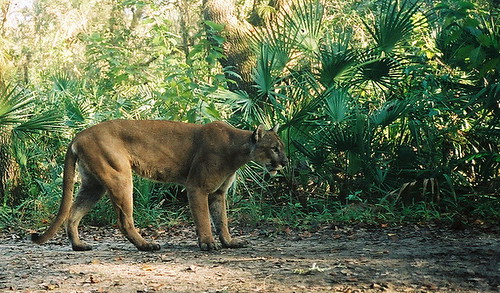TITLE PHOTO CREDIT: “Florida Panther RX 04-04-14” by USFWS/Southeast is marked with CC PDM 1.0
The good news about the National Panther Wildlife Refuge is that it exists at all. This Refuge was established in 1989, and comprises over 26,000 acres of pine forest, oak hammock, and cypress strand habitats on public lands and large private ranches. The bad news is that only a very small portion of the Refuge is open to the public. This severely restricted access is necessary to properly manage the acreage to protect the panthers, so it’s a fair trade. Management efforts include a regular program of prescribed burns and removal of invasive plants. Removal of invasive plants sounds odd in a panther protection scheme, but it is a critical component of habitat management. Invasive plants actually impact how well the burns work to protect the habitat, so managing them is very important to protecting panthers.

Panther Habitat
Panthers must have huge amounts of land to meet their needs. The pine forests and oak hammocks of the Refuge meet these needs, and provide habitat for the deer, wild hogs, and other smaller mammals who make up the bulk of a panther’s diet. They routinely travel through the Refuge to pass from Big Cypress National Preserve to Fakahatchee Strand State Preserve and back. Female panthers often raise their kittens within the preserve.
Public Access
There are two trails that are open the the public. One is a half-mile loop and the other is a 1.3 mile loop. If you visit during the wet summer months, you can expect both trails to be flooded in areas, and you may notice vegetation overgrowing the trail in many places. During the dry months, the trails will still have places that are noticeably damp. A visit in January left us with dry feet. Because it was so cool the week we visited, there were not even mosquitoes! In general, you should always bring plenty of water, bug spray, and sunscreen if you plan to walk either or both of the public trails. Leave your pets at home, because they are not welcome within the Refuge.
We saw a few birds on the trail, but the most interesting feature was the variety of plant life. The signage left a little to be desired, but we reminded ourselves that the Refuge is more for panthers than humans, and panthers don’t need signage.




